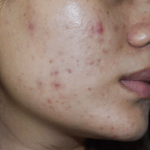
Polycystic ovary syndrome (PCOS) is common and complex. It sits at the intersection of hormones, metabolism, and, for many women, long-term skin and hair concerns. Over recent years, medicines in the GLP-1 receptor agonist family, originally developed for diabetes and now used for medical weight management, have become part of the discussion. Patients ask whether these drugs can help regulate periods, improve chances of ovulation, reduce androgens, or even help with acne.
The short answer: they can help the right patient, for the right reasons, with the right safeguards. The longer answer is set out in our guide below, written by our leading Consultant Dermatologist at Self London.
Why GLP-1 medicines are being used in PCOS
Insulin resistance is a central driver for many women with PCOS. GLP-1 receptor agonists (colloquially “GLP-1s”) such as semaglutide, liraglutide, and exenatide improve glycaemic control, reduce appetite, and support clinically meaningful weight loss. In PCOS cohorts, these metabolic shifts often translate into more regular cycles, better ovulation rates, and lower circulating androgens.
Reviews and meta-analyses show:
- Reductions in BMI and waist circumference
- Improvements in triglycerides
- Decreases in total testosterone
Beyond weight change, some trials suggest reproductive benefits. A meta-analysis comparing exenatide with metformin found higher pregnancy rates and favourable shifts in reproductive hormones with exenatide. This does not make GLP-1 a fertility drug, but it does show that improving metabolic health can restore ovulation in a proportion of women.
Semaglutide data is emerging too. An observational study reported substantial weight loss in PCOS non-responders to lifestyle change, often with normalisation of menstrual cycles. Early-phase studies are now exploring whether combining semaglutide with metformin improves ovulation and insulin resistance more than either alone.
The signal across studies is consistent: in women with PCOS and excess weight, GLP-1 medicines improve metabolic risk and, for many, reproductive parameters. They are not a cure, and they do not replace the need for nutrition, resistance training, and sleep. But they can be an effective medical adjunct when chosen thoughtfully.
What to expect for cycles, skin, and hair
As weight, insulin resistance, and sex hormone-binding globulin (SHBG) production improve, free androgen levels commonly fall. Trials with liraglutide and exenatide show improvements in hyperandrogenism, modest reductions in hirsutism scores, and benefits for acne. These changes are gradual and usually track with the degree of weight loss and metabolic improvement, not the drug alone.
Two caveats:
- Hair shedding: rapid weight loss, from any cause, can trigger temporary shedding (telogen effluvium). This is usually self-limited with adequate protein, iron and general nutrition.
- Breakouts: media speculation about “GLP-1 acne” exists, but high-quality data are lacking. If breakouts occur, they are usually manageable without stopping therapy.
Overall, the evidence points to net benefit for skin and hair once insulin resistance and androgens improve.
Fertility, contraception, and pregnancy planning
GLP-1 drugs can restore ovulation. That is positive if pregnancy is desired, but a risk if it is not. Women who thought of themselves as “infertile” may conceive once their cycles normalise. Effective contraception is essential unless pregnancy is planned.
A practical note: tirzepatide slows gastric emptying enough to reduce absorption of the oral contraceptive pill around initiation and dose increases. Guidance advises switching to a non-oral method or adding barrier protection for four weeks after each dose escalation. This has not been shown with semaglutide, liraglutide, or dulaglutide, although vomiting or diarrhoea at any time can reduce pill efficacy.
If planning pregnancy, GLP-1 medicines are paused in advance.
- Semaglutide: stop at least 2 months before conception.
- Tirzepatide: stop at least 1 month before, though many clinicians prefer longer.
None should be used during pregnancy or breastfeeding.
Risks, side effects, and who should not take them
The most common side-effects are gastrointestinal: nausea, reflux, constipation or diarrhoea. These are usually transient and dose-related. Less common risks include gallbladder disease and pancreatitis. Severe abdominal pain should always be assessed promptly.
Contraindications include personal or family history of medullary thyroid carcinoma or MEN2. Decisions should always be made with a clinician experienced in PCOS, especially if other medicines are involved.
Muscle, skin quality, and the “how” of weight loss
Weight lost too quickly is often a mix of fat and muscle. In PCOS, the metabolic benefits come from fat loss, but losing too much muscle undermines insulin sensitivity, bone health, and long-term metabolism.
Support strategies matter:
- Prioritise high-protein nutrition
- Commit to progressive resistance training
- Begin structured exercise before major weight loss starts
From a dermatology angle, rapid facial fat loss can unmask laxity or hollowing. There is no evidence that GLP-1s directly damage collagen. Visible changes reflect the pace and scale of fat loss, not drug toxicity. Collagen-stimulating treatments can help maintain skin quality while health improves.
Where GLP-1s fit within a PCOS plan
- With excess weight and insulin resistance: GLP-1 may be considered alongside nutrition, training, and sleep. Expect gradual dose increases, monthly reviews, and protein, plus resistance training from week one. Cycles often improve within 3-6 months.
- Lean PCOS: the metabolic rationale is weaker, and other approaches are prioritised. This decision is individual and specialist-led.
- Trying to conceive: GLP-1 medicines are paused, and alternative fertility pathways explored.
- Skin and hair concerns: improvements usually follow metabolic gains. Dermatology care can run in parallel if acne or hair changes remain distressing.
Summary
GLP-1 medicines are not a cure for PCOS. But for women with excess weight and insulin resistance, they can be a valuable tool. Benefits extend from metabolic health to cycle regularity and skin improvement, with careful attention to safety, contraception, and muscle preservation.
At our medical dermatology, laser, and lifestyle clinic on Harley Street, our role is to guide patients through these choices, balancing evidence, safety, and individual goals for long-term health and confidence.
Frequently asked questions about PCOS and GLP-1 medicines
Do GLP-1 medicines improve fertility in PCOS?
GLP-1 medicines can restore ovulation in some women, but they are not fertility drugs.
Will GLP-1s help acne and hirsutism?
Yes, for many. Improvements track with reductions in androgens and weight, but changes are gradual.
Can I take the pill with GLP-1 medication?
Yes, but with tirzepatide, extra precautions are advised during initiation and dose increases.
Do GLP-1s cause hair loss?
Not directly. Temporary shedding can follow rapid weight loss of any cause.
How soon will cycles improve?
In many women, cycles become more predictable within 3-6 months.
Book your consultation at Self London
If you have PCOS and are considering GLP-1 medication, we can help you make sense of the evidence. At Self London, consultant dermatologists and medical weight specialists provide joined-up care that supports hormones, metabolism, skin, and long-term health.
Book your consultation today at our clinic on Harley Street to explore safe, personalised options for PCOS care.
Read our blog on Ozempic face.





